
The Lamborghini Miura is a sports car produced by Italian automaker Lamborghini between 1966 and 1973. The car was the first automobile with a rear mid-engined two-seat layout, although the concept was first seen in a production road car with René Bonnet's Matra Djet, introduced in 1964. This layout has since become the standard for high-performance sports cars. When released, it was the fastest production road car.

The Ferrari 250 GTO is a grand tourer produced by Ferrari from 1962 to 1964 for homologation into the FIA's Group 3 Grand Touring Car category. It was powered by Ferrari's Tipo 168/62 Colombo V12 engine. The "250" in its name denotes the displacement in cubic centimeters of each of its cylinders; "GTO" stands for Gran Turismo Omologato, Italian for "Grand Touring Homologated".

Carrozzeria Touring Superleggera is an Italian automobile coachbuilder. Originally established in Milan in 1925, Carrozzeria Touring became well known for both the beauty of its designs and patented superleggera construction methods. The business folded in 1966. In 2006 its brands and trademarks were purchased and a new firm was established nearby to provide automotive design, engineering, coachbuilding, homologation services, non-automotive industrial design, and restoration of historic vehicles.

Ferrari America is a series of flagship grand touring Ferrari models primarily built for the North American market in the 1950s and 1960s. The America models were equipped with large V12 engines and often had custom bodywork done by famous coachbuilders in Italy. All America models used a live axle in the rear, were front-engined, and had worm and sector steering.

The Ferrari 250 is a series of sports cars and grand tourers built by Ferrari from 1952 to 1964. The company's most successful early line, the 250 series includes many variants designed for road use or sports car racing. 250 series cars are characterized by their use of a 3.0 L (2,953 cc) Colombo V12 engine designed by Gioacchino Colombo. The 250 series designation refers to this engine's cylinder displacement of approximately 250 cc. They were replaced by the 275 and 330 series cars.

Superleggera is a custom tube and alloy panel automobile coachwork construction technology developed by Felice Bianchi Anderloni of Italian coachbuilder Carrozzeria Touring Superleggera. A separate chassis was still required.
The Ferrari P was a series of Italian sports prototype racing cars produced by Ferrari during the 1960s and early 1970s.
The Ferrari 330 was a series of V12 powered automobiles produced by Ferrari in 2+2 GT Coupé, two-seat Berlinetta, spyder, and race car versions between 1963 and 1968. The name "330" refers to the approximate displacement of each single cylinder in cubic centimeters.

The Lamborghini Espada is a 4-seat grand touring coupé built by Italian car manufacturer Lamborghini between 1968 and 1978.

The Lamborghini Islero is a grand tourer produced by Italian automaker Lamborghini between 1968 and 1969. It was the replacement for the 400 GT and featured the Lamborghini V12 engine. The car debuted at the 1968 Geneva Auto Show.

The Lamborghini 350 GT is a grand tourer manufactured by Lamborghini between 1964 and 1966. It was the first production vehicle produced by Lamborghini. The 350 GT was based on the earlier Lamborghini 350 GTV and was equipped with a 3.5 liter V12 engine and a 2-door coupé body by Carrozzeria Touring. The 350 GT debuted at the March 1964 Geneva Motor Show and production began the following May. The success of this model ensured the company's survival, establishing it as a viable competitor with rival manufacturer Ferrari.
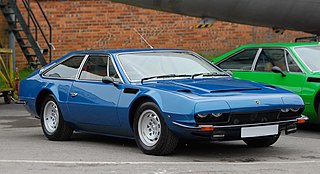
The Lamborghini Jarama is a 2+2 grand tourer manufactured and marketed by Italian car manufacturer Lamborghini between 1970 and 1976. It was styled by Bertone designer Marcello Gandini.
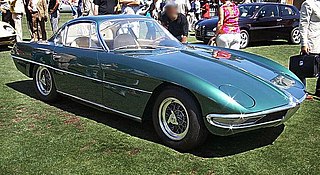
The Lamborghini 350 GTV is a Lamborghini prototype and forerunner of the automaker's first production model, the 350 GT. It was first presented to the public at the 1963 Turin Auto Show.
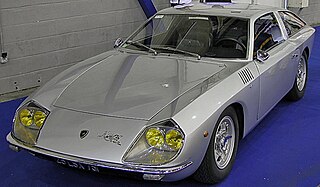
The Lamborghini Flying Star II was a one-off concept car built by Carrozzeria Touring Superleggera in 1966 on a Lamborghini 400 GT chassis. It debuted at the 1966 Turin Auto Show.
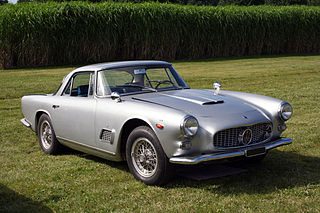
The Maserati 3500 GT and the Maserati 3500 GT Spyder are 2-door coupé and convertible grand tourers made by Italian car manufacturer Maserati between 1957 and 1964. It was a seminal vehicle for Maserati as the company's first successful attempt at the Gran Turismo market and series production.
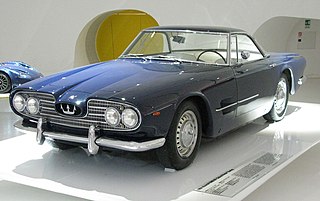
The Maserati 5000 GT is a 2-door coupé grand tourer, made by Italian automobile manufacturer Maserati from 1959–1966. A total of thirty-four were produced with bodies made by eight different Italian coach builders.

The Fiat-Abarth 750 is a compact sporting series of automobiles manufactured by the Italian manufacturing firm Abarth & C. of Turin, Italy in the 1950s and 1960s. The cars used the floorpan and often the bodywork of the Fiat 600 but were fitted with Abarth's modified engines. Abarth also offered a number of bodyworks by other designers for the 750 and its derivatives, most famously Zagato but also Allemano and others.
Neri and Bonacini, also known as Nembo, was a small carrozzeria and mechanic shop based in Modena, Italy, active from the late 1950s to around 1967. Founded and run by Giorgio Neri and Luciano Bonacini, the shop worked on and produced bodies for Ferrari, Lamborghini and Maserati road and race cars, both in an official capacity for those manufacturers and for private owners. Their best known projects are the Ferrari 250 GT-based Nembo spiders and the Lamborghini 400GT Monza. Neri and Bonacini also designed a car under their own name, the Neri and Bonacini Studio GT Due Litri. Two prototypes of this car were made between 1966 and 1968 but it never entered series production. The shop closed around 1967 when Bonacini went to work for De Tomaso and Neri started his own shop, Motors-World-Machines (MWM).
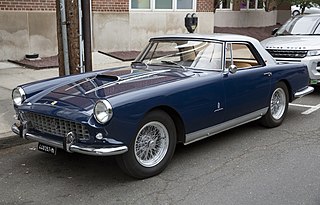
The Ferrari 250 GT Coupé represented a series of road-going, grand touring cars produced by Ferrari between 1954 and 1960. Presented at the 1954 Paris Motor Show, the 250 Europa GT was the first in the GT-lineage. The design by Pinin Farina was seen as a more civilised version of their sporty Berlinetta 250 MM. Series built cars were an answer to the wealthy clientele demands of a sporty and luxurious Ferrari Gran Turismo, that is also easier to use daily.
Thomas Meade was an American automobile designer and dealer best known for his Thomassima series of custom cars based on Ferrari engines and chassis. He was based in Modena, Italy from the early 1960s through the early 1970s, where he met and collaborated with many Modenese carrozzerie, manufacturers and mechanics.





















